| Census of Industrial Production (CIP) - industrial enterprises 2008-2011 | ||||||||
| Percentage change | ||||||||
| 2008 | 2009 | 2010 | 2011 | 2008 - 2011 | 2010 - 2011 | |||
| Turnover - Total (€ million) | 116,350 | 109,736 | 105,754 | 112,300 | -3.5 | 6.2 | ||
| Intermediate consumption (€ million) | 73,826 | 68,787 | 65,376 | 67,708 | -8.3 | 3.6 | ||
| Gross Value Added (€ million) | 35,875 | 33,670 | 34,742 | 38,242 | 6.6 | 10.1 | ||
| Industrial Enterprises (Number) | 5,589 | 5,029 | 4,782 | 5,133 | -8.2 | 7.3 | ||
| Persons engaged (Number) | 216,156 | 195,542 | 185,183 | 188,684 | -12.7 | 1.9 | ||

In 2011 turnover for industrial enterprises increased by 6.2% to over €112 billion. This followed two successive years of decline in the value of industrial turnover. Intermediate consumption also rose in 2011 to almost €68 billion, which was 8.3% less than it was in 2008. Following the continued drop in intermediate consumption and the improvement in turnover, Gross Value Added increased by over 10% in 2011 to €38.2 billion following an increase of 3.2% in 2010 and a decrease of 6.1% in 2009. See Figure 1.

Number of persons engaged in industry up 1.9% in 2011
The number of industrial enterprises and persons engaged in industry increased in 2011 – up 7.3% and 1.9% respectively on 2010 levels. However, these levels were still below 2008 levels, with the number of industrial enterprises in Ireland since 2008 falling from approximately 5,600 to just over 5,100 in 2011. The number of persons engaged in industrial enterprises fell from 216,000 in 2008 to 188,000 in 2011. See Figure 2.
The three sectors that experienced the greatest absolute decline in the number of enterprises in operation from 2008 to 2011 were the Fabricated metal products except machinery & equipment sector (down 87 enterprises), the Wood and wood products except furniture sector (down 63 enterprises) and the Other non-metallic mineral products sector (down 59 enterprises).
The three sectors that experienced the greatest absolute decline in the number of persons engaged from 2008 to 2011 were the Computer, electrical and optical sector (down 7,700 persons), the Other non-metallic mineral products sector (down 3,700 persons) and the Fabricated metal products except machinery & equipment sector (down 3,300 persons).
Chemicals and pharmaceuticals share of total industrial turnover up from 30% in 2008 to 39% in 2011
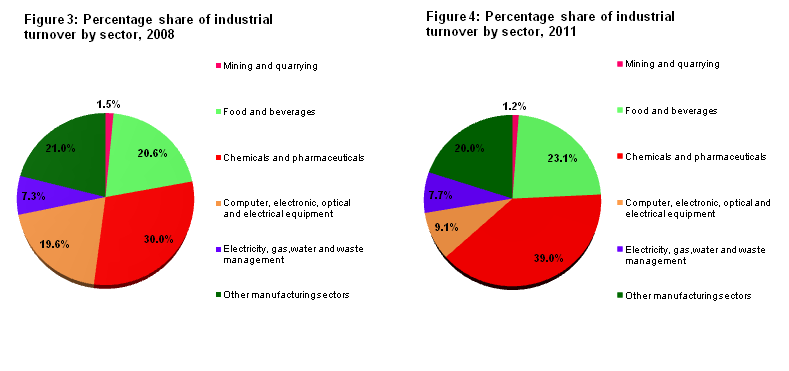
Since 2008 the composition of industrial turnover in Ireland’s economy has changed significantly. In 2008, Chemicals and Pharmaceuticals accounted for 30% of all industrial turnover in Ireland, whereas by 2011, this figure had increased to 39%. The Food and Beverages sector had increased its share of turnover from 20.6% in 2008 to 23.1% in 2011. The Computer, electronic, optical and electrical equipment sector had experienced a sharp fall in its percentage share of total industrial turnover, from 19.6% in 2008 to just 9.1% by 2011. See Figures 3 and 4.
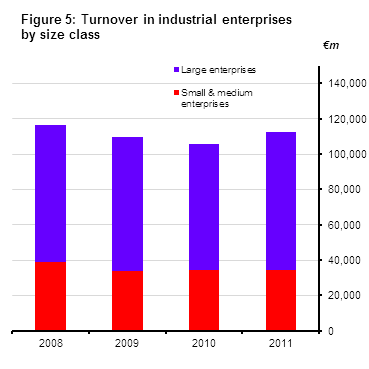
Small and medium enterprises (SMEs) accounted for 30.8% of total industrial turnover in 2011
In 2008 in Ireland, of the €116.3 billion total turnover for industrial enterprises, SMEs (i.e. enterprises who employ 249 persons or less) accounted for €39.1 billion or 33.6% of this. Large enterprises (i.e. those who employ 250 persons or more) accounted for €77.2 billion, or 66.4% of the total industrial turnover.
By 2011 the share of total turnover for SMEs in industry had fallen to €34.6 billion, or 30.8%, of the €112.3 billion total turnover for industrial enterprises in Ireland, while large enterprises accounted for a greater proportion at €77.7 billion, or 69.2% of total industrial turnover. See Figure 5.
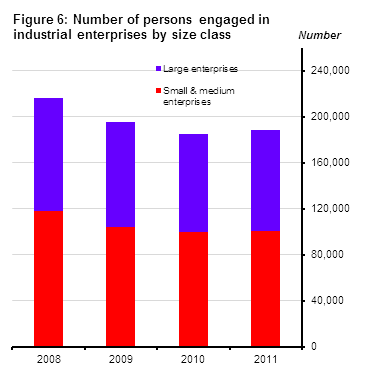
Small and medium enterprises accounted for 53.3% of all persons engaged in industrial enterprises in 2011
In 2008 in Ireland, SMEs had in excess of 117,000 persons engaged in industrial enterprises or 54.4% of the total employment in industry. By 2011, the number of persons engaged in SMEs had fallen to 100,000 or 53.3% of total industrial employment.
Large enterprises had 98,600 persons engaged in industrial enterprises in 2008, that is, 45.6% of all such employment. By 2011, this number had declined to 88,000 but accounted for 46.7% of total employment in industry in Ireland. See Figure 6.
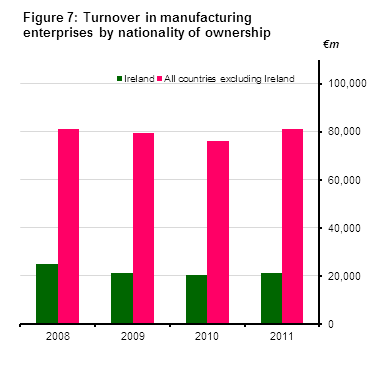
Manufacturing in 2011 accounted for €102.4 billion of total industrial turnover
Manufacturing enterprises in 2011 accounted for €102.4 billion or 91.1% of total industrial turnover in Ireland. Of this, Irish owned manufacturing enterprises accounted for €21.3 billion or 20.8%. Manufacturing turnover for both Irish and foreign owned enterprises rose in 2011, up 4.2% for Irish owned enterprises to €21.3 billion and up 6.5% to €81.1 billion for foreign owned manufacturing enterprises.
In 2011 the value of total turnover in Irish owned manufacturing enterprises was 26.2% of the value of total turnover for foreign owned manufacturing enterprises. See Figure 7.
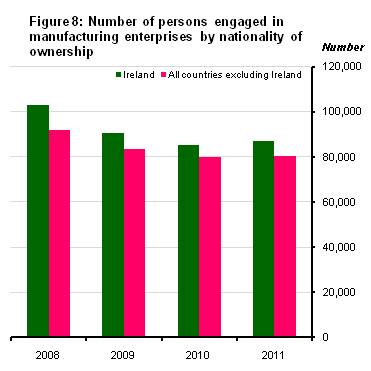
More persons engaged in both foreign owned and Irish owned manufacturing enterprises in 2011 than in 2010
In 2011 there were more persons engaged in both foreign and Irish owned manufacturing enterprises than in 2010. The number of persons engaged in Irish owned manufacturing enterprises increased by 2.1% to 87,000 while in foreign manufacturing enterprises the number of persons engaged rose to 80,400, a yearly increase of 0.7%. 2011 was the first year in which the number of persons engaged in manufacturing enterprises rose year-on-year since the downturn in the economy commenced in 2008.
In 2008, in excess of 103,000 persons were engaged in Irish owned manufacturing enterprises compared to just over 92,000 in foreign owned enterprises. For the years 2008 – 2010, the ratio between Irish and foreign owned manufacturing enterprises was stable at approximately 52% - 48% in favour of Irish owned manufacturing enterprises. See Figure 8.
16.5% of persons employed in the business economy in Ireland worked in industrial enterprises in 2010
In 2010 16.5% of all persons employed in the business economy (NACE sections B - N excluding Financial and Insurance activities) in Ireland were working in industrial enterprises. Across the EU as a whole 24.7% of all persons employed in the business economy worked in industrial enterprises. Slovakia had the highest proportion of persons employed in industrial enterprises at 36.2% while Luxembourg had the lowest proportion at just 13.4%. See Figure 9.
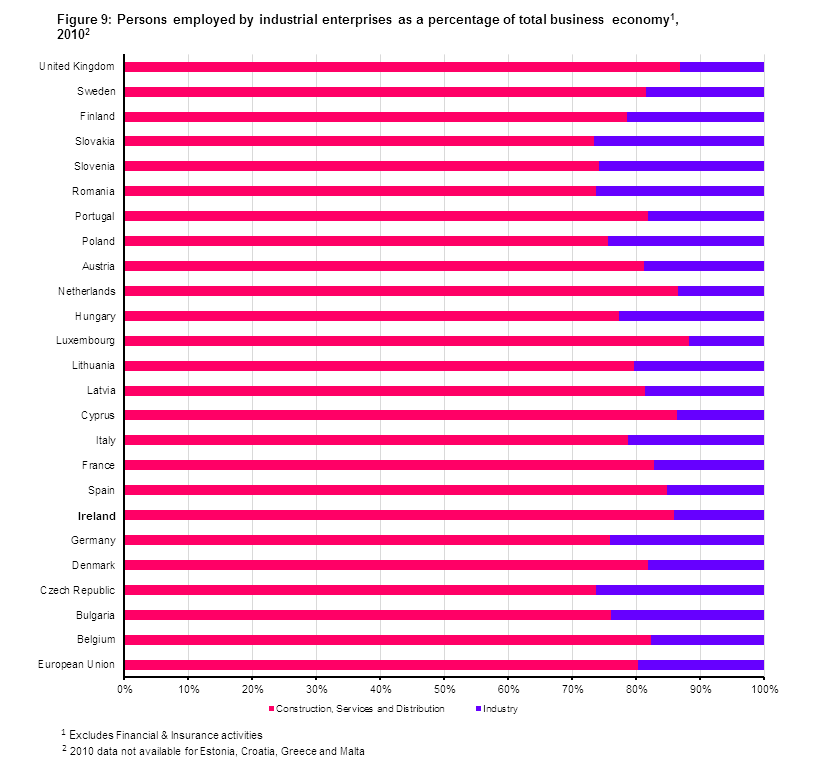
Please use the following links to access Census of Industrial Production data:
Industrial Enterprises link - Click here
Manufacturing Enterprises link - Click here
Eurostat link - Click here
Local Units - CIP 2011 data for Local Units will be published before the end of Q3 2013
Introduction
The Census of Industrial Production comprises two separate but closely related annual inquiries, namely:
(i) the Census of Industrial Enterprises covers those enterprises which are wholly or primarily engaged in industrial production and have three or more persons engaged; published 8 August, 2013.
(ii) the Census of Industrial Local Units which covers all industrial local units with three or more persons engaged. To be published Q3 2013.
The Census of Industrial Production is required under Council Regulation (EC, Euratom) No 58/97. The 2011 Census was taken in accordance with SI 78/2008.
NACE refers to the classification NACE Revision 2 which is the European Union’s Statistical Classification of Economic Activity in the European communities
For further information on the NACE Rev. 2 classification of industrial activity, visit the CSO website:
http://www.cso.ie/en/surveysandmethodology/classifications/
An enterprise is defined as the smallest combination of legal units that is an organisational unit producing goods or services, which benefits from a certain degree of autonomy in decision making, especially for the allocation of its current resources. A local unit is defined as an enterprise or part thereof situated in a geographically identified place.
Appreciation is extended to firms that co-operate in this annual Census. The information they provide is treated as strictly confidential to the Central Statistics Office. Direct or indirect disclosure of information relating to individual respondents is avoided in the publication of results by combining categories containing small numbers of units and suppressing figures, etc. This factor also limits the degree of cross-classification that is possible in presenting results.
Presentation of Results
All tables are available on the Central Statistics Office website, please see
Enterprises Industrial = http://cso.ie/shorturl.aspx/84
Enterprises Manufacturing = http://cso.ie/shorturl.aspx/85
Period Covered by the Census
Although the Census relates in principle to the calendar year, respondents are permitted to return figures for their nearest accounting year. The end of the accounting year for all returns used falls between May of the reference year and April of the following year. Returns which cover a period of less than 12 months are accepted in cases where businesses have started or ceased trading during the year.
All employment details in the 2011 Census relate to the week ending 9 September 2011. Concerns that had no persons engaged in this week (e.g. ceased operations earlier in the year or started production later in the year) were classified as having zero employment. In tables which analyse local units in terms of persons engaged, these are included in the lowest size class, e.g. less than ten persons engaged.
Data Collection
The Census is conducted by post. A permanent up-to-date register is kept of all relevant local units and enterprises known to be involved in industrial production. The register is maintained from the Central Business Register, administrative and public utility records, announcements in the press, business journals, field personnel contacts, etc. This register is constantly being updated. This results in differing estimates for the total number of enterprises/local units through the dissemination cycle.
An ‘enterprise’ questionnaire is sent to all enterprises whose activity is primarily industrial. The type of ‘enterprise’ questionnaire depends on the size of the enterprise. The most detailed form (form F) is generally sent to all enterprises with twenty or more persons engaged. A less detailed form (form C) is sent to enterprises with between three and twenty persons engaged. In previous years the cut-off point was thirteen persons engaged. In the case of multi-location enterprises, a ‘local unit’ questionnaire is sent to each local unit with three or more persons engaged which was in production during the year. For the majority of local units, this questionnaire is the standard form L. In a small number of exceptional cases, a single form L is issued to cover several local units operated by the same enterprise - see Scope of the Local Unit Census below.
All forms are available on CSO’s website at
http://www.cso.ie/en/surveysandmethodology/industry/
In relation to local units involved in NACE Division 36 (Water collection, treatment and supply) a W form is used. This reflects the difference in activity type of these firms.
All returns are scrutinised clerically for internal accuracy. They are compared with returns for previous years and in some instances with returns to other industrial inquiries. Local unit and enterprise returns relating to the same enterprise are examined together for consistency. A further set of consistency checks is carried out in the computer processing of the data. Substantial queries arising from these scrutiny operations are referred to the respondent by telephone, in writing or via a field officer.
Industrial Activity Classification and Statistical Units
The 2011 results are classified by NACE Revision 2, which was first introduced for the year 2008. A correlation table showing the relationship between headings of the old and new classifications is available on request. Each 4 digit class in NACE Revision 2 relates to a specific form of economic activity, eg manufacture of basic pharmaceuticals products (NACE 2110). The statistical units in the Census (local unit and enterprise) are coded to the NACE class relating to their principal industrial activity during the Census year. In the case of local units, this is determined on the basis of detailed information provided on their production of individual products. The activity classification of enterprises is based on the NACE codes of the constituent local units. An enterprise that operates several industrial local units coded to different NACE classes is classified to the activity which accounts for the highest proportion of the total value added of the enterprise.
The scope of the Census extends to NACE sections B,C, D and E, namely:
Section B: Mining and quarrying
Section C: Manufacturing
Section D: Electricity, gas, steam and air conditioning supply
Section E: Water supply; sewerage, waste management and remediation activities
The traditional category Transportable Goods Industries used in industrial statistics is equivalent to NACE sections B and C. The Manufacturing Industries grouping includes only section C.
The classification is determined by the nationality of the owners of 50 per cent or more of the share capital. The breakdown which can be provided at sectoral level is in many cases constrained by the need to preserve the confidentiality of data provided by individual units. For total manufacturing industry, however, a more detailed nationality classification is possible.
Export Performance and the Purchase of Imported Materials
Details are provided on value of output of industrial local units which was exported and the proportion of materials purchased which were imported. The proportions of exports destined for four major markets are also given. These results are presented classified by major industrial sectors, NUTS 2 regions classified by major industrial sector and local units classified by nationality of ownership and number of persons engaged.
These analyses are based on respondents’ replies to questions asking the value of production (or turnover) which was exported and the breakdown by destination, as well as the value of materials purchased which was imported. It must be recognised in interpreting these results that this is information that is not readily available in standard business accounts, particularly in relation to the origin of materials purchased from suppliers.
Census of Industrial Enterprises
Scope and Coverage
The enterprise Census covers all enterprises which have three or more persons engaged and which are wholly or principally involved in industrial production (i.e. NACE Sections B to E).
An enterprise is defined as the smallest combination of legal units that is an organisational unit producing goods or services, which benefits from a certain degree of autonomy in decision making, especially for the allocation of its current resources (e.g. company, partnership, individual proprietorship, etc.). An enterprise may be a sole legal unit. In practice, the enterprise is equivalent to a company or firm. Within a group of companies, each individual company is treated as a separate enterprise. The return for each enterprise relates to all of its activities and covers all local units operated by it, including those involved in non-industrial activity, e.g. wholesaling or retailing.
Estimation for Non-Respondents
If information for key non-respondents is available from an alternative source, for example, Monthly Production, Quarterly Statistics or Prodcom or a return for the previous year, then the record is manually estimated; otherwise a computerised imputation procedure is used. Full data for enterprises filling in the more restricted C forms is derived using a method known as ratio extension. Ratio extension involves the application of ratios between known variables to cases where only one subcomponent is known. The ratios are typically calculated at NACE class level before being applied, although some merging of NACE classes may take place in order to ensure that the ratio estimates are not based on very small populations.
Enterprise Results for 2011
In 2011 there were 5133 enterprises known to the CSO to have three or more persons engaged and to be involved wholly or primarily in industrial production (NACE Sections B,C, D and E). Their total turnover was €112,300 million and purchases of goods and services amounted to €75,008 million. Total gross value added was €38,242 million. The total number of persons engaged in these enterprises (excluding outside piece-workers) in September 2011 was 188,684; labour costs in the year amounted to €9,468 million, of which wages and salaries accounted for €7,812 million.
64% of industrial turnover is classified to the following four NACE classes.
Scope and Coverage
The Census of industrial local units relates to all local units engaged in industrial activity which have on average three or more persons engaged during the year. A local unit is defined as an enterprise or part thereof situated in a geographically identified place. The different geographical locations in which an enterprise conducts industrial activities are treated as separate local units. A separate return is sought for each industrial local unit. The extent to which separate returns are obtained in practice, however, depends on the availability of separate records in the business for the different local units.
If separate details are not available for multi-location enterprises then for those tables involving a classification of local units by size (e.g. number of persons engaged per local unit or gross output per local unit) or by location (county or region) the local units are classified as non-attributable.
Single local units are estimated at enterprise level while multiple local units attached to a single enterprise are estimated by using the enterprise return and apportioning accordingly relative to employment.
Comparison of Local Unit and Enterprise Census
Coverage and Statistical Units
The results for industrial enterprises must be distinguished from the results for industrial local units. Despite the fact that, in the majority of cases, the local unit is equivalent to the enterprise, the use of two different units in the two Censuses has a number of consequences which must be borne in mind when interpreting and comparing their results, namely:
Variables
The local unit Census focuses on the industrial process, namely the utilisation of materials, industrial services and labour, and the value of goods produced during the year. The most important variables distinguished are, therefore, gross output, industrial input and net output. Gross output represents the selling value of goods actually produced in the year, as reported by the businesses themselves, irrespective of whether sold or put into stock. Industrial input is defined as the cost of materials, industrial services and fuel and power used in the year. Net output is gross output less industrial input.
The enterprise Census, on the other hand, relates to the trading dimension, namely turnover, purchases of materials and services and labour costs during the year. One of the main variables in this Census is, therefore, turnover, which represents the revenue received during the year. This can be compared with gross output by means of the derived variable production value. This variable approximates closely to the value of gross output of the industrial local units operated by the enterprises. The different treatment of excise duties and operating subsidies in the two Censuses makes comparison more difficult for the small number of industries affected by these factors.
The variable in the enterprise Census which approximates most closely to industrial input is intermediate consumption which is defined as the purchases of materials, industrial and non-industrial services and fuel and power less the rise (or plus the fall) during the year of stocks of materials and fuels. The main difference, therefore, is the inclusion of non-industrial services in intermediate consumption. In the enterprise Census gross value added (excluding VAT) is defined as production value less intermediate consumption; this is the closest approximation to net output as distinguished in the local unit Census.
 Hide Background Notes
Hide Background Notes
Scan the QR code below to view this release online or go to
http://www.cso.ie/en/releasesandpublications/er/cip/censusofindustrialproductionenterprises2011/